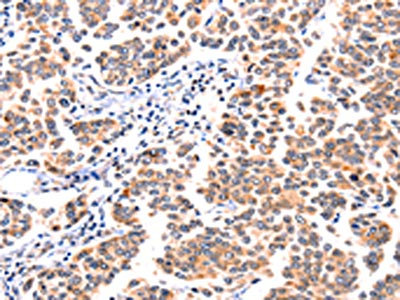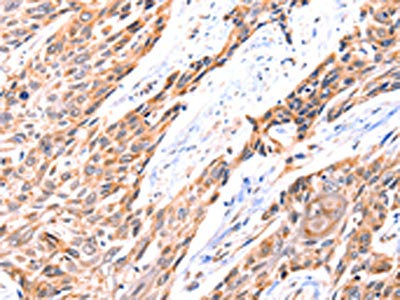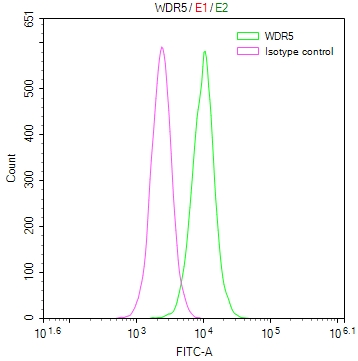GNRHR Antibody
-
中文名稱:GNRHR兔多克隆抗體
-
貨號:CSB-PA823966
-
規格:¥1100
-
圖片:
-
The image on the left is immunohistochemistry of paraffin-embedded Human breast cancer tissue using CSB-PA823966(GNRHR Antibody) at dilution 1/117, on the right is treated with synthetic peptide. (Original magnification: ×200)
-
The image on the left is immunohistochemistry of paraffin-embedded Human esophagus cancer tissue using CSB-PA823966(GNRHR Antibody) at dilution 1/117, on the right is treated with synthetic peptide. (Original magnification: ×200)
-
Gel: 10%SDS-PAGE, Lysate: 40 μg, Lane 1-2: 231 cells, mouse testis tissue, Primary antibody: CSB-PA823966(GNRHR Antibody) at dilution 1/2350, Secondary antibody: Goat anti rabbit IgG at 1/8000 dilution, Exposure time: 25 seconds
-
-
其他:
產品詳情
-
Uniprot No.:
-
基因名:
-
別名:GNRHR; GRHR; Gonadotropin-releasing hormone receptor; GnRH receptor; GnRH-R
-
宿主:Rabbit
-
反應種屬:Human,Mouse,Rat
-
免疫原:Synthetic peptide of Human GNRHR
-
免疫原種屬:Homo sapiens (Human)
-
標記方式:Non-conjugated
-
抗體亞型:IgG
-
純化方式:Antigen affinity purification
-
濃度:It differs from different batches. Please contact us to confirm it.
-
保存緩沖液:-20°C, pH7.4 PBS, 0.05% NaN3, 40% Glycerol
-
產品提供形式:Liquid
-
應用范圍:ELISA,WB,IHC
-
推薦稀釋比:
Application Recommended Dilution ELISA 1:1000-1:10000 WB 1:2000-1:5000 IHC 1:150-1:500 -
Protocols:
-
儲存條件:Upon receipt, store at -20°C or -80°C. Avoid repeated freeze.
-
貨期:Basically, we can dispatch the products out in 1-3 working days after receiving your orders. Delivery time maybe differs from different purchasing way or location, please kindly consult your local distributors for specific delivery time.
-
用途:For Research Use Only. Not for use in diagnostic or therapeutic procedures.
相關產品
靶點詳情
-
功能:Receptor for gonadotropin releasing hormone (GnRH) that mediates the action of GnRH to stimulate the secretion of the gonadotropic hormones luteinizing hormone (LH) and follicle-stimulating hormone (FSH). This receptor mediates its action by association with G-proteins that activate a phosphatidylinositol-calcium second messenger system. Isoform 2 may act as an inhibitor of GnRH-R signaling.
-
基因功能參考文獻:
- Data, including identification of GnRH/GnRH-receptor system in both ovary and endometrium, suggest that the spectrum of action of GnRH/GnRH-receptor system extends outside its well-known hypothalamic functions. [REVIEW] PMID: 29544634
- c.364C>T in GNRHR is a complete loss-of-function mutation which caused idiopathic hypogonadotropic hypogonadism. PMID: 29777911
- GNRHR (and GNRH) are expressed in trophoblast cell populations and fallopian tube epithelium at tubal ectopic pregnancy sites. PMID: 26920257
- first description of a GNRHR gene mutation in three patients diagnosed with polycystic ovary syndrome. PMID: 28348023
- We showed that GNRHR and LHCGR were highly expressed in some wildtype aldosterone-producing adenoma samples, and that they positively correlated with GnRH-stimulated aldosterone production. PMID: 27196470
- Results show that biallelic gonadotropin releasing hormone receptor (GNRHR) mutations are not a frequent cause of age-related androgen decline in men. PMID: 26044071
- GnRH receptors on triple negative breast cancer cells can be used for targeted therapy of these cancers with GnRH agonist triptorelin PMID: 25293576
- study found a novel mutation in PROK2 in two male siblings presenting normosmic congenital hypogonadotropic hypogonadism, in whom a mutation in the GNRHR gene had been previously described, suggesting the possibility of a digenic inheritance PMID: 25531638
- A high prevalence of endometriosis, polymorphism in the LHCGR and GnRH1 and progonadoliberin-2 antibodies in serum was found among the patients with severe dysmotility after treatment with GnRH analogs. PMID: 25592315
- Mutations in GNRHR do not appear to be involved in the pathogenesis of constitutional delay of growth and puberty. PMID: 25016926
- Studies of the gonadotrope suggest that extracellular regulatory loops may play a central role in the regulation of gonadotropin gene expression by gonadotropin-releasing hormone (GnRH) receptor activation. PMID: 23994024
- Interaction between ER-associated Hsp40s and the Vps34 complex permits the selective degradation of ERAD-resistant membrane protein GNRHR via ERQC autophagy. PMID: 24685158
- A species specific motif participates in recognition of endoplasmic reticulum retention of the GnRHR by calnexin. PMID: 23891857
- The GnRH receptor is differentially expressed in pituitary gonadotrope cells vs. prostate cancer cells. PMID: 23380421
- We have generated human GNRHR1 knock-in mice and described their reproductive phenotype. PMID: 23632635
- Reversal of hyogonadotropic hypogonadism and late-onset hypogonadism are reported in an untreated patient with a R262Q mutation of GNRHR. PMID: 22788855
- Data show that GnRHR activation affected several cellular markers of locomotion, including actin organization and polymerization as well as active RhoA-GTP levels. PMID: 23176180
- SET protein interacts with intracellular domains of the gonadotropin-releasing hormone receptor and differentially regulates receptor signaling to cAMP and calcium in gonadotrope cells PMID: 23233674
- Review of the role of GNRHR in neoplasms and as a treatment target. [Review Article] PMID: 22778172
- Data suggest that mutations in GNRHR and TACR3 are the most common causative mutations in normosmic idiopathic hypogonadotropic hypogonadism in families in Turkey. PMID: 22766261
- GnRHR mutations can be classified into partial or complete loss of function mutations. Partially inactivating substitutions of the GnRHR frequently found in familial hypogonadotrophic hypogonadism are Q106R and R262Q. PMID: 23155690
- Normosmic Congenital hypogonadotropic hypogonadism (HH)patients with a R262Q mutation in GHRHR accompanied by other GNRHR mutation may be prone to reversal of HH. PMID: 22724017
- unidentified genetic and/or environmental factors may combine with singly mutated GNRHR alleles to produce reproductive phenotypes PMID: 22745237
- A potential role of GnRHR gene polymorphisms in the development of breast cancer. PMID: 22710726
- Molecular deficiencies of the two novel GNRHR1 mutations lead to the CHH phenotype when present as a compound heterozygote. PMID: 22679506
- molecular mechanisms involved in GnRH/GnRHR signaling at the maternal-fetal interface. {Review] PMID: 22024993
- Hypogonadotropic hypogonadism due to being homozygous for the G416A transition in the GNRHR gene. The parents were heterozygous mutation carriers. PMID: 21717411
- the TM4/ECL2 junction of GNRHR is crucial for peptide ligand binding and, consequently, for ligand-induced receptor conformational selection PMID: 21832286
- Thr104Ile and Tyr108Cys gonadotropin-releasing hormone receptors are misfolded structures whose function is rescuable by genetic and/or pharmacological strategies PMID: 21277937
- Positioning of the long extracellular loop within the seven-alpha-helical bundle regulates GnRH receptor stability, proper trafficking, and function. PMID: 21527534
- P-cadherin cooperates with insulin-like growth factor-1 receptor to promote metastatic signaling of gonadotropin-releasing hormone in ovarian cancer via p120 catenin. PMID: 21317933
- The findings suggest novel pathophysiological links between the GNRHR locus and thyroid function and insulin secretion in polycystic ovary syndrome patients. PMID: 21274726
- Data suggest that a subset of patients with primary aldosteronism has aberrant LHR and GNRHR expression, which could modulate aldosterone secretion. PMID: 21330483
- we discuss the composition and role of membrane rafts in cell signaling and examine evidence that the mammalian type I GnRHR is constitutively and exclusively localized to these membrane microdomains in various experimental model--REVIEW PMID: 20836995
- LH-RH receptor expression persisted despite prolonged exposure to LH-RH agonists in prostate cancer. PMID: 20670943
- GnRHa may be an effective stimulator of local peritoneal fibrinolytic activity, as it decreases PAI-1 secretion in peritoneal Met5A cells by a mechanism linked to GnRHR. PMID: 20236028
- Study conclude that the mammalian GnRH-RI is an intracellular GPCR that is expressed on the nuclear membrane. PMID: 20628612
- analysis of Pulsatile and sustained gonadotropin-releasing hormone (GnRH) receptor signaling PMID: 20507982
- Data show that among those GnRH receptor monoclonal antibodies, GHR-103, GHR-106 and GHR-114 exhibit high affinity and specificity to GnRH receptor as judged by the whole cell binding. PMID: 20182875
- Site-directed mutagenesis of the C-terminal domain of extracellular loop 2 of the human GnRH receptor showed that a minimum of two mutations is needed in this region for agonist activity of antagonist 135-18 PMID: 11981042
- the E(90)K mutation impairs hGnRHR-effector coupling; sequence modifications that enhance surface expression of the receptor restore function PMID: 11994356
- Novel homozygous splice acceptor site GnRH receptor (GnRHR) mutation: human GnRHR "knockout". amenorrhea and absent thelarche and pubarche PMID: 12050282
- conserved physical linkage in medaka and human genomes PMID: 12054603
- our results strongly indicate a role of the C/EBP and GATA motifs in regulating GnRHR gene transcription in human granulosa-luteal cells PMID: 12089350
- Locally expressed LHRH receptors mediate the oncostatic and antimetastatic activity of LHRH agonists on melanoma cells. PMID: 12161512
- results clearly indicate a role of octamer transcription factor-1 in the transcriptional repression of the human gonadotropin-releasing hormone receptor gene PMID: 12446597
- A missense mutation in this gene is found in a case of complete hypogonadotropic hypogonadism. PMID: 12568864
- The dominant-negative effect of the naturally occurring receptor mutants for the WT hGnRHR, which has intrinsic low maturation efficiency suggesting that this effect and the diminished plasma membrane expression is a recent evolutionary event. PMID: 12843188
- direct role for the GnRHR in mediating antiproliferative events in two cell systems, neither of which was derived from extrapituitary reproductive tumors. PMID: 14551223
- Neurons express GnRH receptor and responded to GnRH with time- and dose-dependent increases in GnRH gene expression and protein release. PMID: 14565958
顯示更多
收起更多
-
相關疾病:Hypogonadotropic hypogonadism 7 with or without anosmia (HH7)
-
亞細胞定位:Cell membrane; Multi-pass membrane protein.
-
蛋白家族:G-protein coupled receptor 1 family
-
組織特異性:Pituitary, ovary, testis, breast and prostate but not in liver and spleen.
-
數據庫鏈接:
Most popular with customers
-
-
YWHAB Recombinant Monoclonal Antibody
Applications: ELISA, WB, IHC, IF, FC
Species Reactivity: Human, Mouse, Rat
-
Phospho-YAP1 (S127) Recombinant Monoclonal Antibody
Applications: ELISA, WB, IHC
Species Reactivity: Human
-
-
-
-
-






















